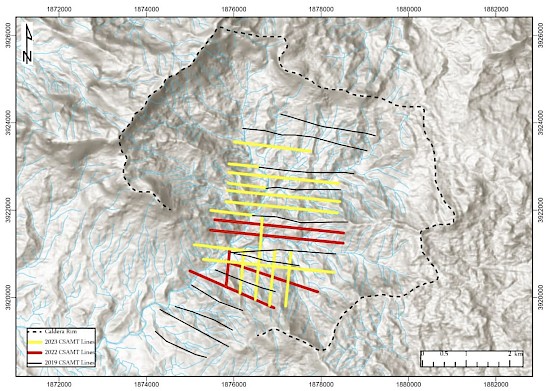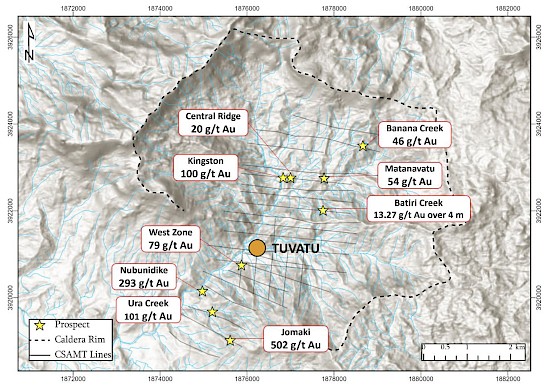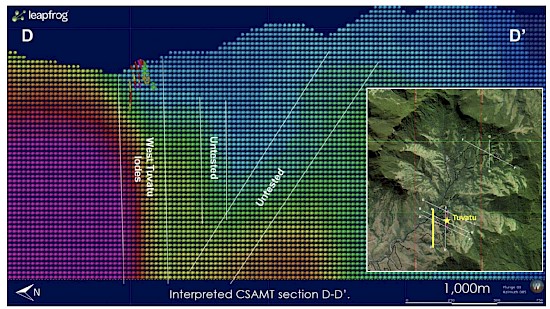North Vancouver, B.C., June 20, 2023 - Lion One Metals Limited (TSX-V: LIO) (OTCQX: LOMLF) (ASX: LLO) (“Lion One” or the “Company”) is pleased to announce that it has completed a CSAMT (Controlled Source Audio-frequency Magnetotellurics) survey at its 100% owned Tuvatu Alkaline Gold Project in Fiji.
Highlights:
- 14 new CSAMT survey lines were completed, including 7 across the main Tuvatu deposit area.
- 3 lines from the 2019 CSAMT survey were extended.
- Station density has doubled from 100 m in the 2019 survey to 50 m in the 2022-23 survey.
- Line spacing has halved from an average of 560 m in 2019 to an average of 300 m in 2023.
- A total of approximately 33 line-kms were surveyed (11 km in 2022 and 22 km in 2023).
- CSAMT processing and interpretation is expected to be complete in July; increased resolution of the CSAMT data will be used to generate high quality drill targets across the Navilawa caldera.
Lion One Chairman and CEO Walter Berukoff commented: “We’re thrilled to have completed our CSAMT survey and we eagerly await the results of the survey, which we hope to have available later in July. The 2019 survey was invaluable in helping us to discover the feeder zone underlying Tuvatu and led us directly to the 500 Zone, where we intersected 75.9 m of 20.86 g/t Au.1 The 2022-2023 survey will complement the 2019 survey and will dramatically improve survey resolution across the property, where we have already identified numerous exciting and untested prospects. The CSAMT data will help us to identify and refine drill targets underlying those prospects and we look forward to drill testing select targets later in 2023.”
Figure 1. Location of 2022-2023 CSAMT Survey Lines.
1 Refer Company news release dated 6 June 2022.
CSAMT Overview
CSAMT is a ground geophysical method used for obtaining information about subsurface resistivity in a survey area. It measures the electrical resistivity of rocks down to depths of approximately 1.2 to 1.5 km, which is much deeper than alternative resistivity techniques. The survey identifies areas of bedrock with contrasting electrical properties, often due to variations in lithology, porosity, or alteration. Abrupt changes in resistivity occur when two rock types with differing resistivity characteristics are juxtaposed against one another, or when an area is highly fractured and allows groundwater to penetrate resistive rocks thereby producing an area of lower resistivity. CSAMT surveys are highly beneficial in identifying subsurface structures, such as lithological contact zones, faults, and fracture systems, especially if these are deep-rooted structures.
In alkaline gold deposits such as Tuvatu, it is these deep-rooted structures that provide the conduits for fluid flow to rise up in the earth’s crust and in which gold is deposited. When interpreting CSAMT data, the main focus is on steep resistivity gradients that may indicate the presence of such structures. CSAMT surveys are the pre-eminent geophysical tool in identifying mineralized structures and drill targets in alkaline gold deposits.
2022-2023 Survey
Lion One’s 2022-2023 CSAMT survey was designed to complement the 2019 survey by adding infill and extension lines to the previous survey area. The 2019 survey was moderate to widely spaced, with line spacing ranging from 300 m to 800 m, and station spacing every 100 m. Line and station spacing has improved significantly across the Navilawa Caldera following the 2022-2023 CSAMT survey, with line spacing ranging from 100 m to 400 m, and station spacing only 50 m apart on all new lines (Figure 1). The increased line and station density will provide greater resolution across the property and will assist in refining and generating new drill targets in the caldera.
The 2022-2023 CSAMT survey was conducted by Zonge Engineering and Research Organization of Adelaide, Australia. The 2022 portion of the survey was completed on October 8th, 2022 and the 2023 portion was completed on June 10th, 2023. A total of 33 line-km were surveyed, with 11 km completed in 2022 and 22 km completed in 2023. In addition to the 22.5 line-km surveyed in 2019, Lion One has now surveyed a total of 55.5 line-km of CSAMT across the Navilawa Caldera. Notably, the 2022-2023 survey included 5 survey lines oriented north-south across the main Tuvatu deposit, providing a high-density grid of coverage across the Tuvatu area. This will provide high-quality resistivity data for the Tuvatu deposit and all near-mine exploration targets, such as the West Zone.
Lion One has also identified numerous regional prospects throughout the Navilawa Caldera, with multiple surface samples returning grades of over 100 g/t Au (Figure 2). One of the goals of the 2022-2023 CSAMT survey was to improve coverage and understanding of the structural architecture underlying these prospects, some of which are located on the edge of the 2019 survey lines where results can be less reliable. The 2022-2023 infill and extension lines will dramatically improve survey resolution and reliability in these areas and will help refine drill targets underlying those prospects.
The 2022-2023 CSAMT survey was originally planned for 2021 but was delayed by the COVID-19 pandemic. The 2022-2023 survey was completed under budget.
Figure 2. Select Regional Prospects. Select regional prospects covered by the CSAMT survey area. The goal of the CSAMT survey is to define high resolution structures underlying these prospects and to thereby identify high priority drill targets. All grades shown are peak results from surface samples, either rock chips or channel samples. Refer to the November 15th, 2022 news release and the April 22nd, 2022 technical report for full contextualization of data.
Figure 3. Example 2019 CSAMT Interpretation, West Zone. The 2019 CSAMT survey identified several resistivity gradients in the area of the West Zone which may indicate a potential new feeder zone. The 2022-2023 CSAMT infill and extension lines in this area will increase resolution and help to refine drill targets in the West Zone. Warm colors indicate areas of high resistivity, cool colors indicate areas of low resistivity. Inset map shows the location of this interpretation section in relation to the Navilawa caldera, with the D-D’ line highlighted in yellow and the main Tuvatu deposit indicated by the star. The 2019 survey, including this figure, is the subject of a news release dated February 5, 2020.
About Tuvatu
The Tuvatu Alkaline Gold Project is located on the island of Viti Levu in Fiji. The January 2018 mineral resource for Tuvatu as disclosed in the technical report “Technical Report and Preliminary Economic Assessment for the Tuvatu Gold Project, Republic of Fiji”, dated September 25, 2020, and prepared by Mining Associates Pty Ltd of Brisbane Qld, comprises 1,007,000 tonnes indicated at 8.50 g/t Au (274,600 oz. Au) and 1,325,000 tonnes inferred at 9.0 g/t Au (384,000 oz. Au) at a cut-off grade of 3.0 g/t Au. The technical report is available on the Lion One website at www.liononemetals.com and on the SEDAR website at www.sedar.com.
Qualified Person
In accordance with National Instrument 43-101 – Standards of Disclosure for Mineral Projects (“NI 43- 101”), Sergio Cattalani, P.Geo, Senior Vice President Exploration, is the Qualified Person for the Company and has reviewed and is responsible for the technical and scientific content of this news release.
About Lion One Metals Limited
Lion One’s flagship asset is 100% owned, fully permitted high grade Tuvatu Alkaline Gold Project, located on the island of Viti Levu in Fiji. Lion One envisions a low-cost high-grade underground gold mining operation at Tuvatu coupled with exciting exploration upside inside its tenements covering the entire Navilawa Caldera, an underexplored yet highly prospective 7km diameter alkaline gold system. Lion One’s CEO Walter Berukoff leads an experienced team of explorers and mine builders and has owned or operated over 20 mines in 7 countries. As the founder and former CEO of Miramar Mines, Northern Orion, and La Mancha Resources, Walter is credited with building over $3 billion of value for shareholders.
On behalf of the Board of Directors of
Lion One Metals Limited
“Walter Berukoff”, Chairman and CEO
Contact Investor Relations
Toll Free (North America) Tel: 1-855-805-1250
Email: info@liononemetals.com
Website: www.liononemetals.com
Neither the TSX Venture Exchange nor its Regulation Service Provider accepts responsibility for the adequacy or accuracy of this release
This press release may contain statements that may be deemed to be "forward-looking statements" within the meaning of applicable Canadian securities legislation. All statements, other than statements of historical fact, included herein are forward-looking information. Generally, forward-looking information may be identified by the use of forward-looking terminology such as "plans", "expects" or "does not expect", "proposed", "is expected", "budget", "scheduled", "estimates", "forecasts", "intends", "anticipates" or "does not anticipate", or "believes", or variations of such words and phrases, or by the use of words or phrases which state that certain actions, events or results may, could, would, or might occur or be achieved. This forward-looking information reflects Lion One Metals Limited’s current beliefs and is based on information currently available to Lion One Metals Limited and on assumptions Lion One Metals Limited believes are reasonable. These assumptions include, but are not limited to, the actual results of exploration projects being equivalent to or better than estimated results in technical reports, assessment reports, and other geological reports or prior exploration results. Forward-looking information is subject to known and unknown risks, uncertainties and other factors that may cause the actual results, level of activity, performance or achievements of Lion One Metals Limited or its subsidiaries to be materially different from those expressed or implied by such forward-looking information. Such risks and other factors may include, but are not limited to: the stage development of Lion One Metals Limited, general business, economic, competitive, political and social uncertainties; the actual results of current research and development or operational activities; competition; uncertainty as to patent applications and intellectual property rights; product liability and lack of insurance; delay or failure to receive board or regulatory approvals; changes in legislation, including environmental legislation, affecting mining, timing and availability of external financing on acceptable terms; not realizing on the potential benefits of technology; conclusions of economic evaluations; and lack of qualified, skilled labour or loss of key individuals. Although Lion One Metals Limited has attempted to identify important factors that could cause actual results to differ materially from those contained in forward-looking information, there may be other factors that cause results not to be as anticipated, estimated or intended. Accordingly, readers should not place undue reliance on forward-looking information. Lion One Metals Limited does not undertake to update any forward-looking information, except in accordance with applicable securities laws.
JORC Code, 2012 Edition – Table 1 report template
Section 1 Sampling Techniques and Data
(Criteria in this section apply to all succeeding sections.)
|
Criteria |
JORC Code explanation |
Commentary |
|---|---|---|
|
Sampling techniques |
|
|
|
Drilling techniques |
|
|
|
Drill sample recovery |
|
|
|
Logging |
|
|
|
Sub-sampling techniques and sample preparation |
|
|
|
Quality of assay data and laboratory tests |
|
CSAMT Geophysics CSAMT geophysics is undertaken by a qualified geophysical survey company—Zonge Engineering and Research Organization. Zonge constructs and calibrates its own equipment. CSAMT survey lines are shown at variable spacing based on access and geological targets and as shown in the body of the release. Sample station spacing is 50m along line. With modelling of controlled and natural source, and based on results from the 2019 survey, the Company understands that CSAMT can cause predictions of resistivity and resistivity/conductivity contrasts from the near survey to >1000m. |
|
Verification of sampling and assaying |
|
|
|
Location of data points |
|
CSAMT Geophysics
|
|
Data spacing and distribution |
|
CSAMT Geophysics
|
|
Orientation of data in relation to geological structure |
|
CSAMT
|
|
Sample security |
|
|
|
Audits or reviews |
|
CSAMT Geophysics Geophysical data (CSAMT) is reviewed and processed by Zonge Engineering and Research Organization of Adelaide, Australia. The Company uses independent consultant, Thomas Weis, of Colorado to process the data and conduct interpretations. |
Section 2 Reporting of Exploration Results
(Criteria listed in the preceding section also apply to this section.)
|
Criteria |
JORC Code explanation |
Commentary |
|---|---|---|
|
Mineral tenement and land tenure status |
|
|
|
Exploration done by other parties |
|
|
|
Geology |
|
|
|
Drill hole Information |
|
|
|
Data aggregation methods |
|
|
|
Relationship between mineralisation widths and intercept lengths |
|
|
|
Diagrams |
|
|
|
Balanced reporting |
|
|
|
Other substantive exploration data |
|
CSAMT Geophysics
|
|
Further work |
|
|
Remaining Sections “Section 3 Estimation and Reporting of Mineral Resources”, “Section 4 Estimation and Reporting of Ore Reserves” not applicable to this release.



